An Evaluation of Job Satisfaction in Public and Private Sector: Report
VerifiedAdded on 2021/10/11
|10
|2327
|48
Report
AI Summary
This report provides a comprehensive evaluation of job satisfaction, comparing and contrasting the public and private sectors. It begins with an introduction outlining the research background and objectives, followed by a literature review that explores the meaning and concept of job satisfaction, including factors such as job stability and career growth. The report examines job satisfaction in both sectors, highlighting differences in motivational tools and work environments. It identifies key challenges, such as lack of motivation and communication issues, and recommends strategies for improvement, including the use of motivational tools, digital communication, and training and development programs. The methodology section details the use of interpretivism, inductive approaches, and mixed research designs. The report concludes with recommendations for enhancing employee satisfaction, emphasizing the importance of direct communication, training, and the use of digital tools. The research also highlights the importance of productivity, reward systems, and HRM policies in achieving job satisfaction. Finally, it draws a conclusion based on the provided evidence and references.
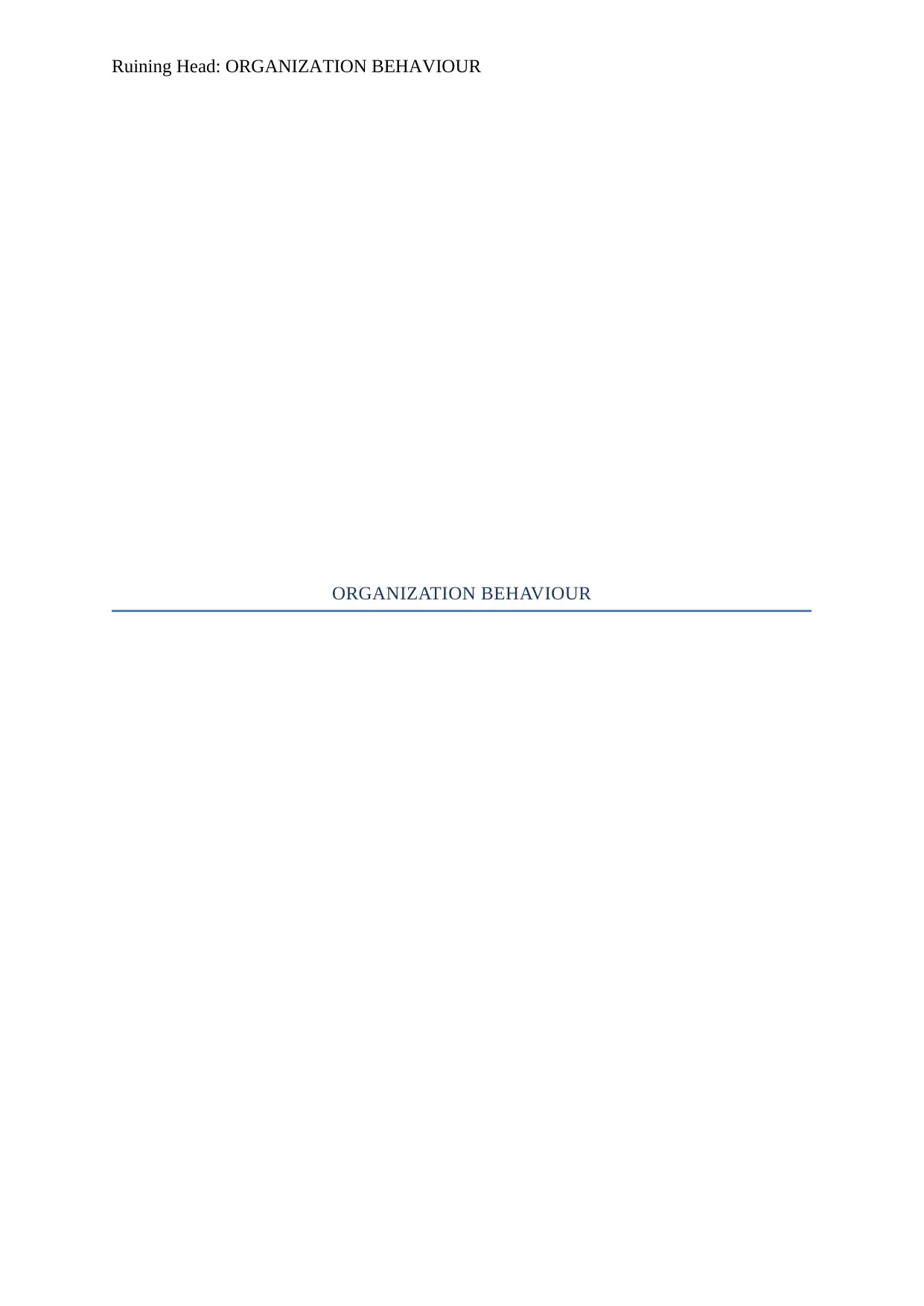
Ruining Head: ORGANIZATION BEHAVIOUR
ORGANIZATION BEHAVIOUR
ORGANIZATION BEHAVIOUR
Paraphrase This Document
Need a fresh take? Get an instant paraphrase of this document with our AI Paraphraser
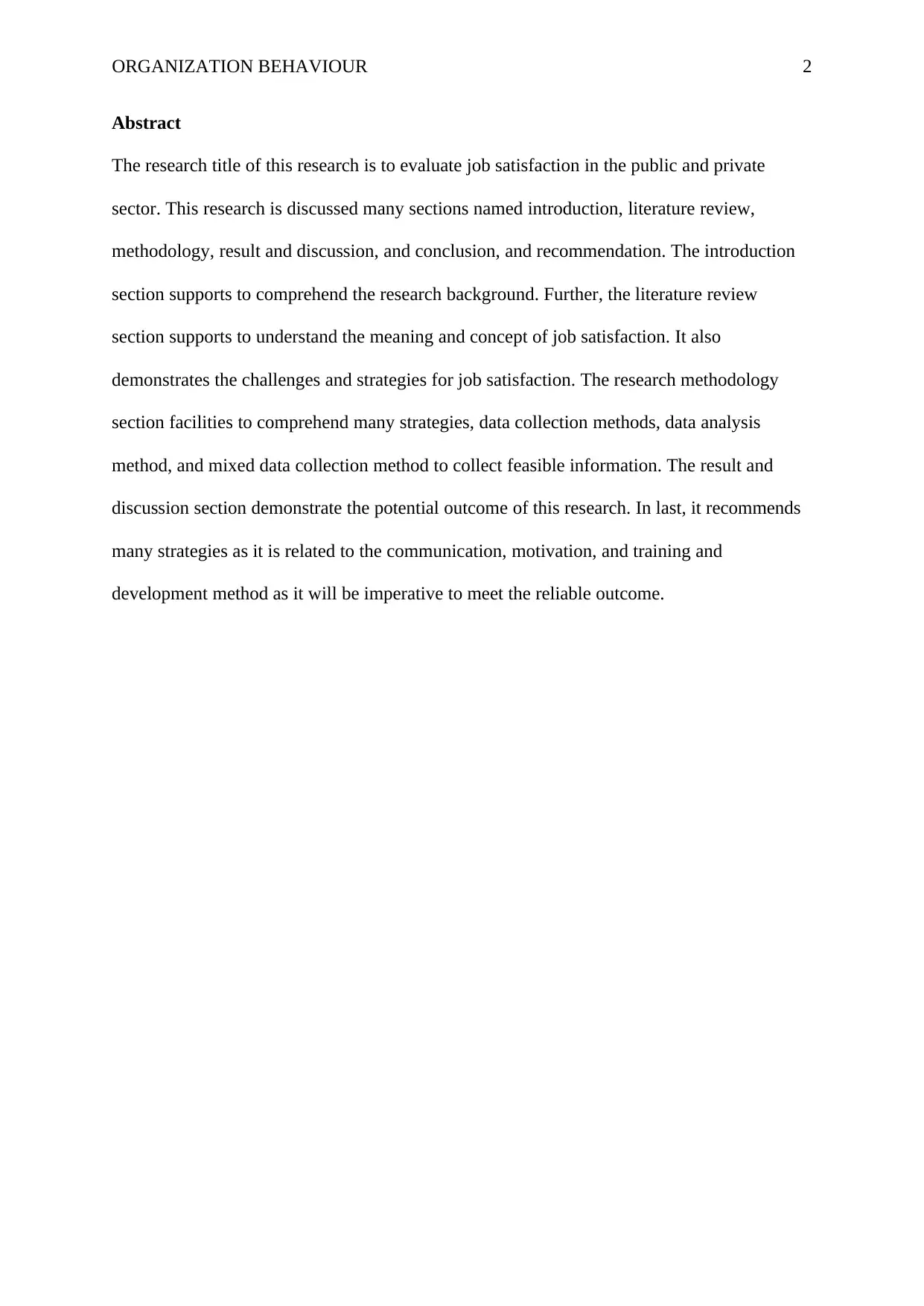
ORGANIZATION BEHAVIOUR 2
Abstract
The research title of this research is to evaluate job satisfaction in the public and private
sector. This research is discussed many sections named introduction, literature review,
methodology, result and discussion, and conclusion, and recommendation. The introduction
section supports to comprehend the research background. Further, the literature review
section supports to understand the meaning and concept of job satisfaction. It also
demonstrates the challenges and strategies for job satisfaction. The research methodology
section facilities to comprehend many strategies, data collection methods, data analysis
method, and mixed data collection method to collect feasible information. The result and
discussion section demonstrate the potential outcome of this research. In last, it recommends
many strategies as it is related to the communication, motivation, and training and
development method as it will be imperative to meet the reliable outcome.
Abstract
The research title of this research is to evaluate job satisfaction in the public and private
sector. This research is discussed many sections named introduction, literature review,
methodology, result and discussion, and conclusion, and recommendation. The introduction
section supports to comprehend the research background. Further, the literature review
section supports to understand the meaning and concept of job satisfaction. It also
demonstrates the challenges and strategies for job satisfaction. The research methodology
section facilities to comprehend many strategies, data collection methods, data analysis
method, and mixed data collection method to collect feasible information. The result and
discussion section demonstrate the potential outcome of this research. In last, it recommends
many strategies as it is related to the communication, motivation, and training and
development method as it will be imperative to meet the reliable outcome.
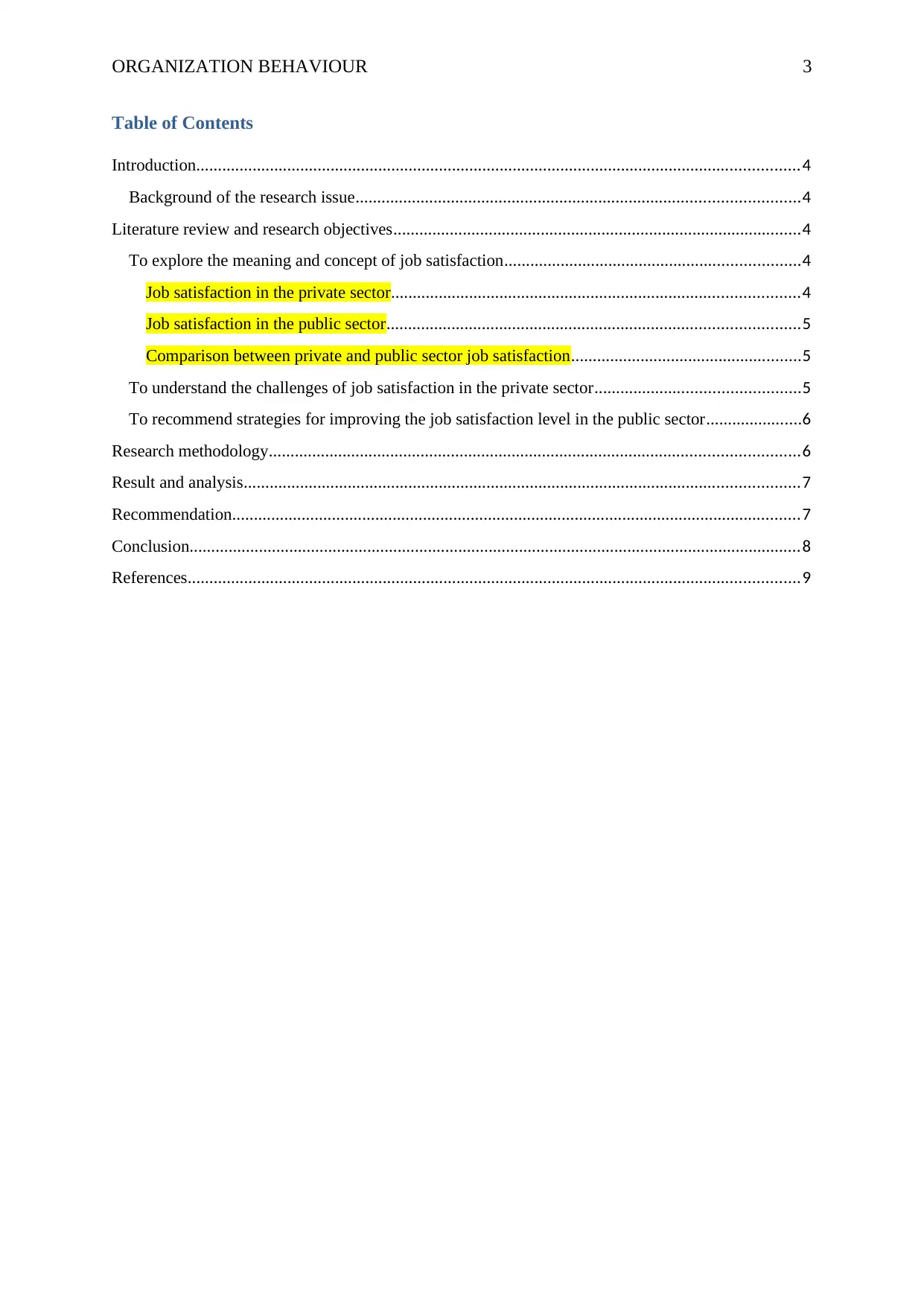
ORGANIZATION BEHAVIOUR 3
Table of Contents
Introduction...........................................................................................................................................4
Background of the research issue......................................................................................................4
Literature review and research objectives..............................................................................................4
To explore the meaning and concept of job satisfaction....................................................................4
Job satisfaction in the private sector..............................................................................................4
Job satisfaction in the public sector...............................................................................................5
Comparison between private and public sector job satisfaction.....................................................5
To understand the challenges of job satisfaction in the private sector...............................................5
To recommend strategies for improving the job satisfaction level in the public sector......................6
Research methodology..........................................................................................................................6
Result and analysis................................................................................................................................7
Recommendation...................................................................................................................................7
Conclusion.............................................................................................................................................8
References.............................................................................................................................................9
Table of Contents
Introduction...........................................................................................................................................4
Background of the research issue......................................................................................................4
Literature review and research objectives..............................................................................................4
To explore the meaning and concept of job satisfaction....................................................................4
Job satisfaction in the private sector..............................................................................................4
Job satisfaction in the public sector...............................................................................................5
Comparison between private and public sector job satisfaction.....................................................5
To understand the challenges of job satisfaction in the private sector...............................................5
To recommend strategies for improving the job satisfaction level in the public sector......................6
Research methodology..........................................................................................................................6
Result and analysis................................................................................................................................7
Recommendation...................................................................................................................................7
Conclusion.............................................................................................................................................8
References.............................................................................................................................................9
⊘ This is a preview!⊘
Do you want full access?
Subscribe today to unlock all pages.

Trusted by 1+ million students worldwide
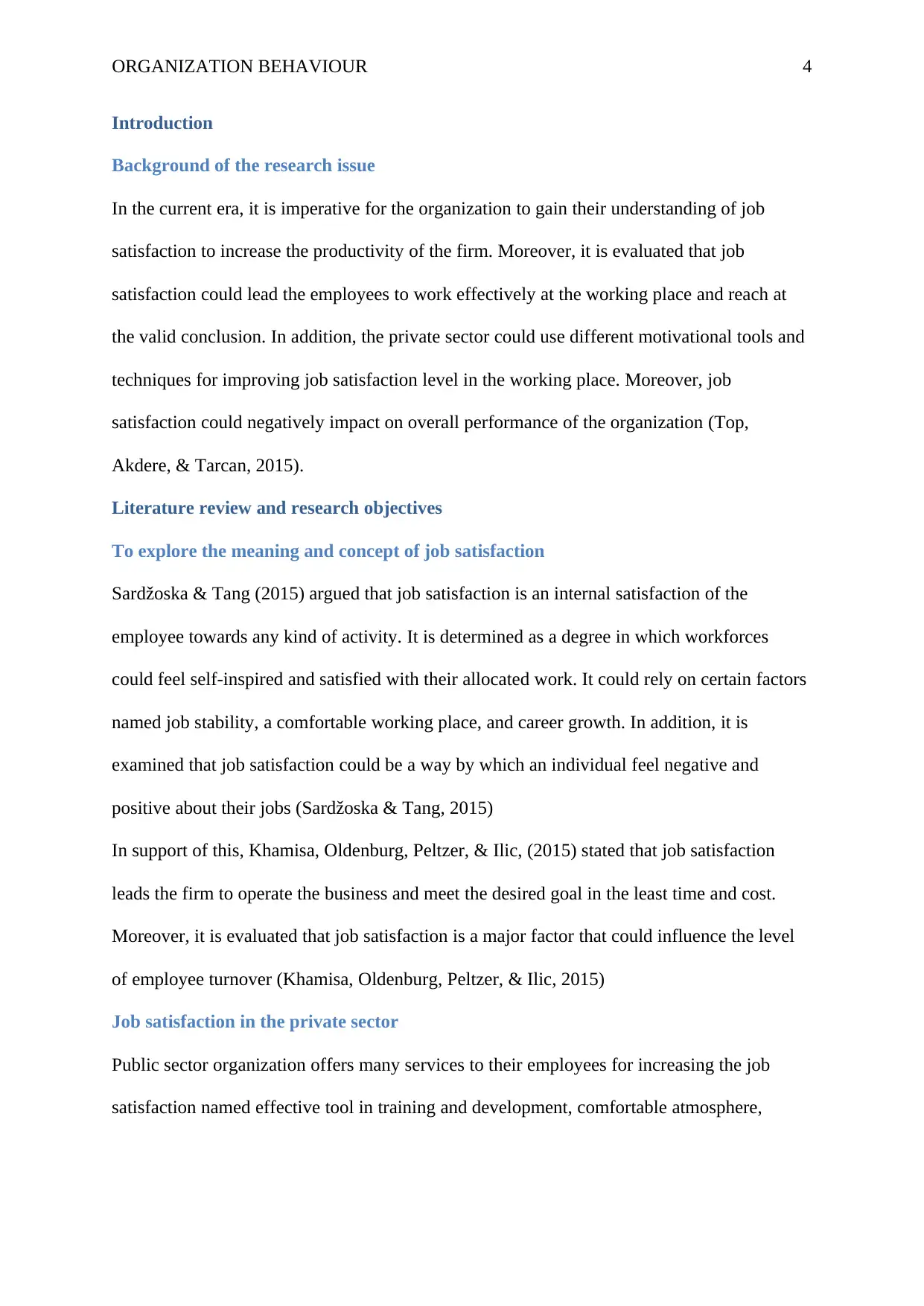
ORGANIZATION BEHAVIOUR 4
Introduction
Background of the research issue
In the current era, it is imperative for the organization to gain their understanding of job
satisfaction to increase the productivity of the firm. Moreover, it is evaluated that job
satisfaction could lead the employees to work effectively at the working place and reach at
the valid conclusion. In addition, the private sector could use different motivational tools and
techniques for improving job satisfaction level in the working place. Moreover, job
satisfaction could negatively impact on overall performance of the organization (Top,
Akdere, & Tarcan, 2015).
Literature review and research objectives
To explore the meaning and concept of job satisfaction
Sardžoska & Tang (2015) argued that job satisfaction is an internal satisfaction of the
employee towards any kind of activity. It is determined as a degree in which workforces
could feel self-inspired and satisfied with their allocated work. It could rely on certain factors
named job stability, a comfortable working place, and career growth. In addition, it is
examined that job satisfaction could be a way by which an individual feel negative and
positive about their jobs (Sardžoska & Tang, 2015)
In support of this, Khamisa, Oldenburg, Peltzer, & Ilic, (2015) stated that job satisfaction
leads the firm to operate the business and meet the desired goal in the least time and cost.
Moreover, it is evaluated that job satisfaction is a major factor that could influence the level
of employee turnover (Khamisa, Oldenburg, Peltzer, & Ilic, 2015)
Job satisfaction in the private sector
Public sector organization offers many services to their employees for increasing the job
satisfaction named effective tool in training and development, comfortable atmosphere,
Introduction
Background of the research issue
In the current era, it is imperative for the organization to gain their understanding of job
satisfaction to increase the productivity of the firm. Moreover, it is evaluated that job
satisfaction could lead the employees to work effectively at the working place and reach at
the valid conclusion. In addition, the private sector could use different motivational tools and
techniques for improving job satisfaction level in the working place. Moreover, job
satisfaction could negatively impact on overall performance of the organization (Top,
Akdere, & Tarcan, 2015).
Literature review and research objectives
To explore the meaning and concept of job satisfaction
Sardžoska & Tang (2015) argued that job satisfaction is an internal satisfaction of the
employee towards any kind of activity. It is determined as a degree in which workforces
could feel self-inspired and satisfied with their allocated work. It could rely on certain factors
named job stability, a comfortable working place, and career growth. In addition, it is
examined that job satisfaction could be a way by which an individual feel negative and
positive about their jobs (Sardžoska & Tang, 2015)
In support of this, Khamisa, Oldenburg, Peltzer, & Ilic, (2015) stated that job satisfaction
leads the firm to operate the business and meet the desired goal in the least time and cost.
Moreover, it is evaluated that job satisfaction is a major factor that could influence the level
of employee turnover (Khamisa, Oldenburg, Peltzer, & Ilic, 2015)
Job satisfaction in the private sector
Public sector organization offers many services to their employees for increasing the job
satisfaction named effective tool in training and development, comfortable atmosphere,
Paraphrase This Document
Need a fresh take? Get an instant paraphrase of this document with our AI Paraphraser
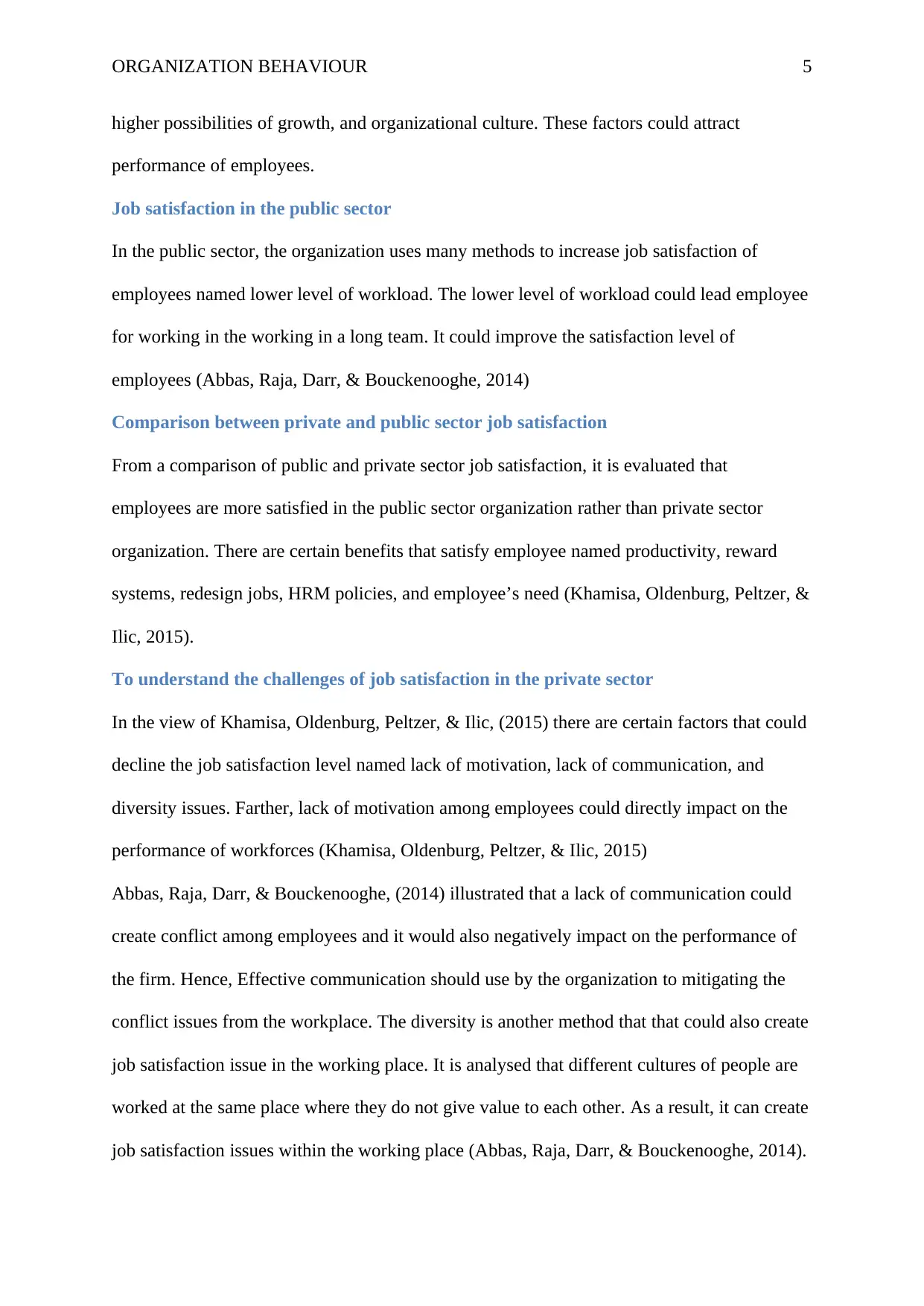
ORGANIZATION BEHAVIOUR 5
higher possibilities of growth, and organizational culture. These factors could attract
performance of employees.
Job satisfaction in the public sector
In the public sector, the organization uses many methods to increase job satisfaction of
employees named lower level of workload. The lower level of workload could lead employee
for working in the working in a long team. It could improve the satisfaction level of
employees (Abbas, Raja, Darr, & Bouckenooghe, 2014)
Comparison between private and public sector job satisfaction
From a comparison of public and private sector job satisfaction, it is evaluated that
employees are more satisfied in the public sector organization rather than private sector
organization. There are certain benefits that satisfy employee named productivity, reward
systems, redesign jobs, HRM policies, and employee’s need (Khamisa, Oldenburg, Peltzer, &
Ilic, 2015).
To understand the challenges of job satisfaction in the private sector
In the view of Khamisa, Oldenburg, Peltzer, & Ilic, (2015) there are certain factors that could
decline the job satisfaction level named lack of motivation, lack of communication, and
diversity issues. Farther, lack of motivation among employees could directly impact on the
performance of workforces (Khamisa, Oldenburg, Peltzer, & Ilic, 2015)
Abbas, Raja, Darr, & Bouckenooghe, (2014) illustrated that a lack of communication could
create conflict among employees and it would also negatively impact on the performance of
the firm. Hence, Effective communication should use by the organization to mitigating the
conflict issues from the workplace. The diversity is another method that that could also create
job satisfaction issue in the working place. It is analysed that different cultures of people are
worked at the same place where they do not give value to each other. As a result, it can create
job satisfaction issues within the working place (Abbas, Raja, Darr, & Bouckenooghe, 2014).
higher possibilities of growth, and organizational culture. These factors could attract
performance of employees.
Job satisfaction in the public sector
In the public sector, the organization uses many methods to increase job satisfaction of
employees named lower level of workload. The lower level of workload could lead employee
for working in the working in a long team. It could improve the satisfaction level of
employees (Abbas, Raja, Darr, & Bouckenooghe, 2014)
Comparison between private and public sector job satisfaction
From a comparison of public and private sector job satisfaction, it is evaluated that
employees are more satisfied in the public sector organization rather than private sector
organization. There are certain benefits that satisfy employee named productivity, reward
systems, redesign jobs, HRM policies, and employee’s need (Khamisa, Oldenburg, Peltzer, &
Ilic, 2015).
To understand the challenges of job satisfaction in the private sector
In the view of Khamisa, Oldenburg, Peltzer, & Ilic, (2015) there are certain factors that could
decline the job satisfaction level named lack of motivation, lack of communication, and
diversity issues. Farther, lack of motivation among employees could directly impact on the
performance of workforces (Khamisa, Oldenburg, Peltzer, & Ilic, 2015)
Abbas, Raja, Darr, & Bouckenooghe, (2014) illustrated that a lack of communication could
create conflict among employees and it would also negatively impact on the performance of
the firm. Hence, Effective communication should use by the organization to mitigating the
conflict issues from the workplace. The diversity is another method that that could also create
job satisfaction issue in the working place. It is analysed that different cultures of people are
worked at the same place where they do not give value to each other. As a result, it can create
job satisfaction issues within the working place (Abbas, Raja, Darr, & Bouckenooghe, 2014).
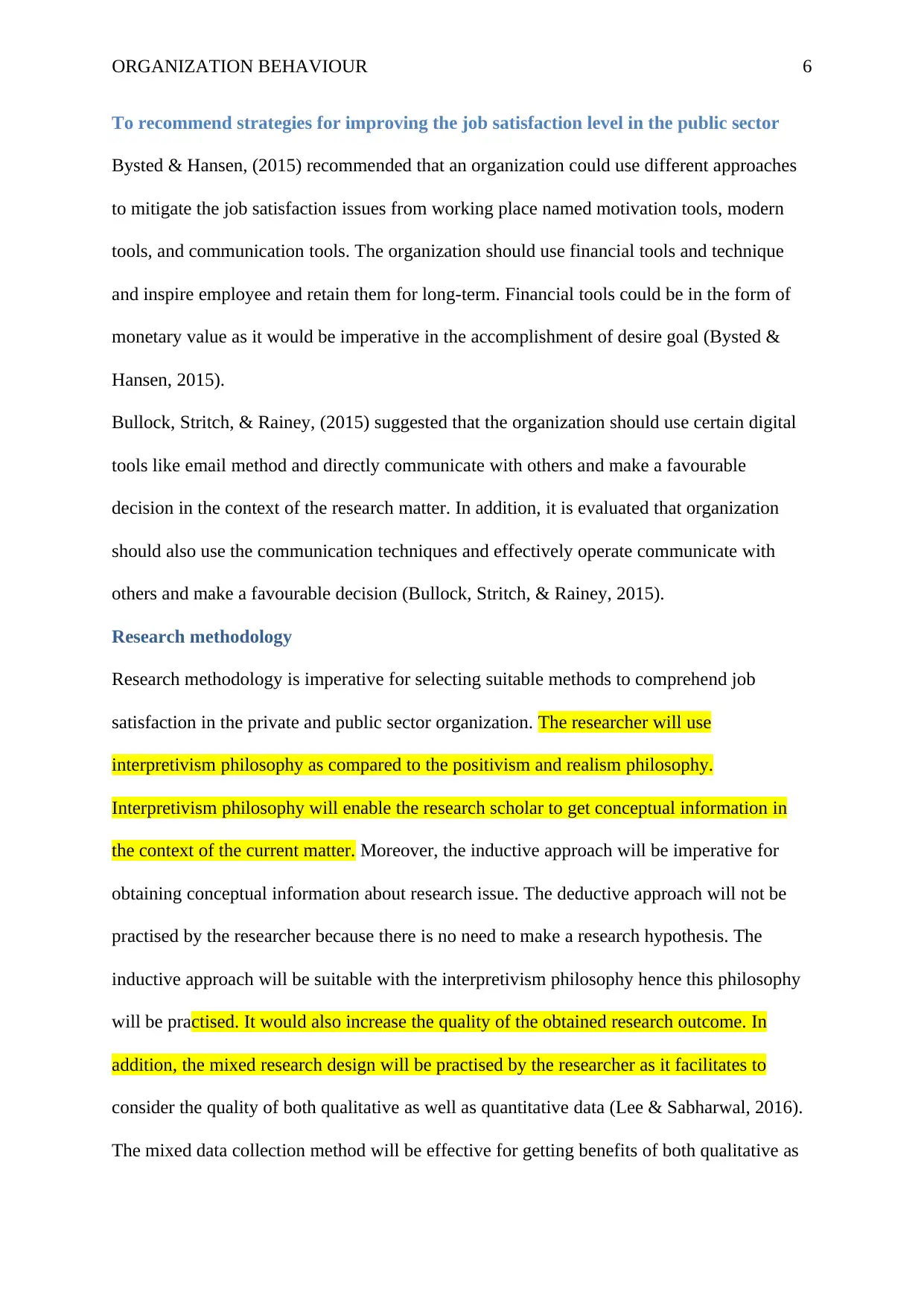
ORGANIZATION BEHAVIOUR 6
To recommend strategies for improving the job satisfaction level in the public sector
Bysted & Hansen, (2015) recommended that an organization could use different approaches
to mitigate the job satisfaction issues from working place named motivation tools, modern
tools, and communication tools. The organization should use financial tools and technique
and inspire employee and retain them for long-term. Financial tools could be in the form of
monetary value as it would be imperative in the accomplishment of desire goal (Bysted &
Hansen, 2015).
Bullock, Stritch, & Rainey, (2015) suggested that the organization should use certain digital
tools like email method and directly communicate with others and make a favourable
decision in the context of the research matter. In addition, it is evaluated that organization
should also use the communication techniques and effectively operate communicate with
others and make a favourable decision (Bullock, Stritch, & Rainey, 2015).
Research methodology
Research methodology is imperative for selecting suitable methods to comprehend job
satisfaction in the private and public sector organization. The researcher will use
interpretivism philosophy as compared to the positivism and realism philosophy.
Interpretivism philosophy will enable the research scholar to get conceptual information in
the context of the current matter. Moreover, the inductive approach will be imperative for
obtaining conceptual information about research issue. The deductive approach will not be
practised by the researcher because there is no need to make a research hypothesis. The
inductive approach will be suitable with the interpretivism philosophy hence this philosophy
will be practised. It would also increase the quality of the obtained research outcome. In
addition, the mixed research design will be practised by the researcher as it facilitates to
consider the quality of both qualitative as well as quantitative data (Lee & Sabharwal, 2016).
The mixed data collection method will be effective for getting benefits of both qualitative as
To recommend strategies for improving the job satisfaction level in the public sector
Bysted & Hansen, (2015) recommended that an organization could use different approaches
to mitigate the job satisfaction issues from working place named motivation tools, modern
tools, and communication tools. The organization should use financial tools and technique
and inspire employee and retain them for long-term. Financial tools could be in the form of
monetary value as it would be imperative in the accomplishment of desire goal (Bysted &
Hansen, 2015).
Bullock, Stritch, & Rainey, (2015) suggested that the organization should use certain digital
tools like email method and directly communicate with others and make a favourable
decision in the context of the research matter. In addition, it is evaluated that organization
should also use the communication techniques and effectively operate communicate with
others and make a favourable decision (Bullock, Stritch, & Rainey, 2015).
Research methodology
Research methodology is imperative for selecting suitable methods to comprehend job
satisfaction in the private and public sector organization. The researcher will use
interpretivism philosophy as compared to the positivism and realism philosophy.
Interpretivism philosophy will enable the research scholar to get conceptual information in
the context of the current matter. Moreover, the inductive approach will be imperative for
obtaining conceptual information about research issue. The deductive approach will not be
practised by the researcher because there is no need to make a research hypothesis. The
inductive approach will be suitable with the interpretivism philosophy hence this philosophy
will be practised. It would also increase the quality of the obtained research outcome. In
addition, the mixed research design will be practised by the researcher as it facilitates to
consider the quality of both qualitative as well as quantitative data (Lee & Sabharwal, 2016).
The mixed data collection method will be effective for getting benefits of both qualitative as
⊘ This is a preview!⊘
Do you want full access?
Subscribe today to unlock all pages.

Trusted by 1+ million students worldwide
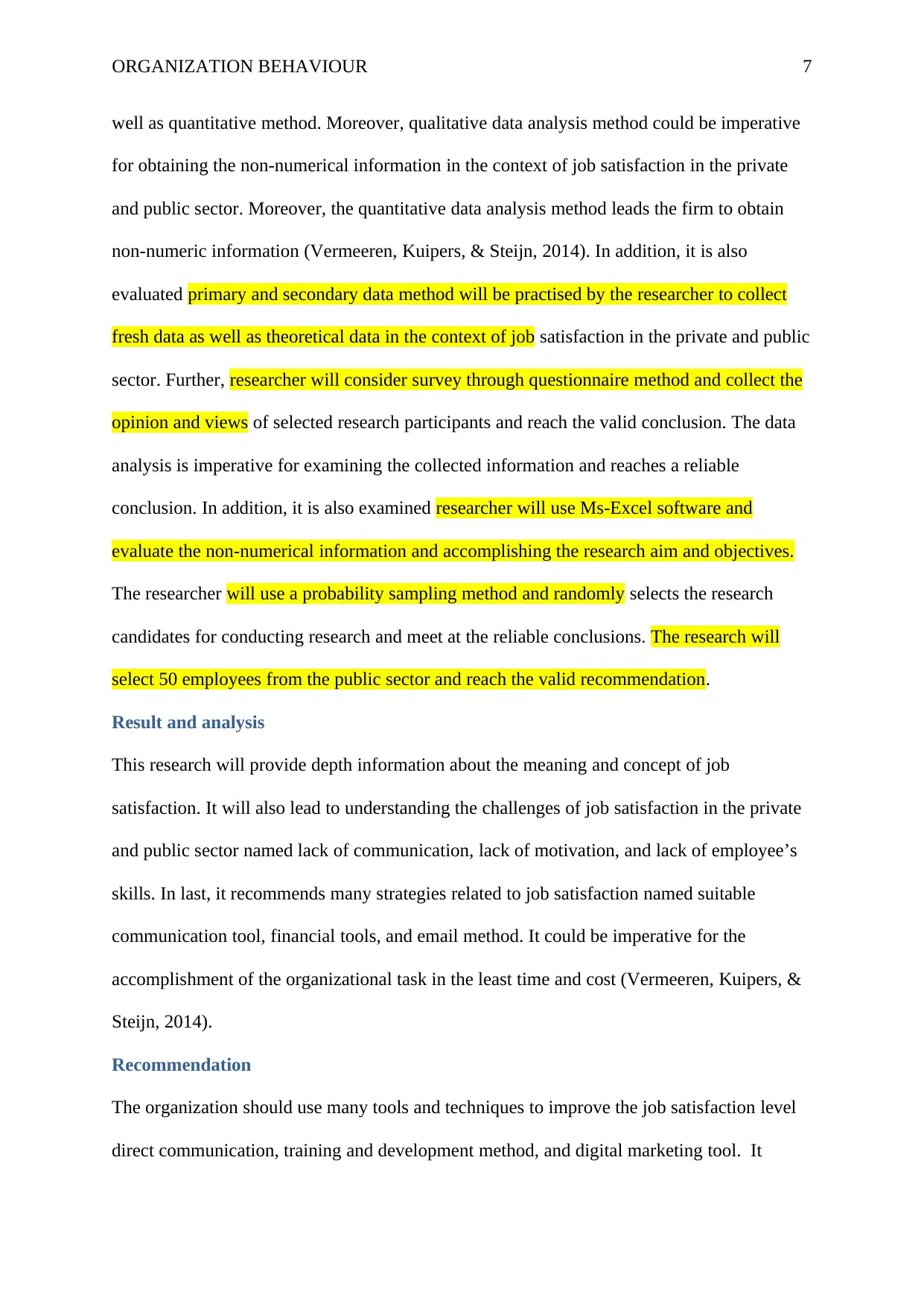
ORGANIZATION BEHAVIOUR 7
well as quantitative method. Moreover, qualitative data analysis method could be imperative
for obtaining the non-numerical information in the context of job satisfaction in the private
and public sector. Moreover, the quantitative data analysis method leads the firm to obtain
non-numeric information (Vermeeren, Kuipers, & Steijn, 2014). In addition, it is also
evaluated primary and secondary data method will be practised by the researcher to collect
fresh data as well as theoretical data in the context of job satisfaction in the private and public
sector. Further, researcher will consider survey through questionnaire method and collect the
opinion and views of selected research participants and reach the valid conclusion. The data
analysis is imperative for examining the collected information and reaches a reliable
conclusion. In addition, it is also examined researcher will use Ms-Excel software and
evaluate the non-numerical information and accomplishing the research aim and objectives.
The researcher will use a probability sampling method and randomly selects the research
candidates for conducting research and meet at the reliable conclusions. The research will
select 50 employees from the public sector and reach the valid recommendation.
Result and analysis
This research will provide depth information about the meaning and concept of job
satisfaction. It will also lead to understanding the challenges of job satisfaction in the private
and public sector named lack of communication, lack of motivation, and lack of employee’s
skills. In last, it recommends many strategies related to job satisfaction named suitable
communication tool, financial tools, and email method. It could be imperative for the
accomplishment of the organizational task in the least time and cost (Vermeeren, Kuipers, &
Steijn, 2014).
Recommendation
The organization should use many tools and techniques to improve the job satisfaction level
direct communication, training and development method, and digital marketing tool. It
well as quantitative method. Moreover, qualitative data analysis method could be imperative
for obtaining the non-numerical information in the context of job satisfaction in the private
and public sector. Moreover, the quantitative data analysis method leads the firm to obtain
non-numeric information (Vermeeren, Kuipers, & Steijn, 2014). In addition, it is also
evaluated primary and secondary data method will be practised by the researcher to collect
fresh data as well as theoretical data in the context of job satisfaction in the private and public
sector. Further, researcher will consider survey through questionnaire method and collect the
opinion and views of selected research participants and reach the valid conclusion. The data
analysis is imperative for examining the collected information and reaches a reliable
conclusion. In addition, it is also examined researcher will use Ms-Excel software and
evaluate the non-numerical information and accomplishing the research aim and objectives.
The researcher will use a probability sampling method and randomly selects the research
candidates for conducting research and meet at the reliable conclusions. The research will
select 50 employees from the public sector and reach the valid recommendation.
Result and analysis
This research will provide depth information about the meaning and concept of job
satisfaction. It will also lead to understanding the challenges of job satisfaction in the private
and public sector named lack of communication, lack of motivation, and lack of employee’s
skills. In last, it recommends many strategies related to job satisfaction named suitable
communication tool, financial tools, and email method. It could be imperative for the
accomplishment of the organizational task in the least time and cost (Vermeeren, Kuipers, &
Steijn, 2014).
Recommendation
The organization should use many tools and techniques to improve the job satisfaction level
direct communication, training and development method, and digital marketing tool. It
Paraphrase This Document
Need a fresh take? Get an instant paraphrase of this document with our AI Paraphraser
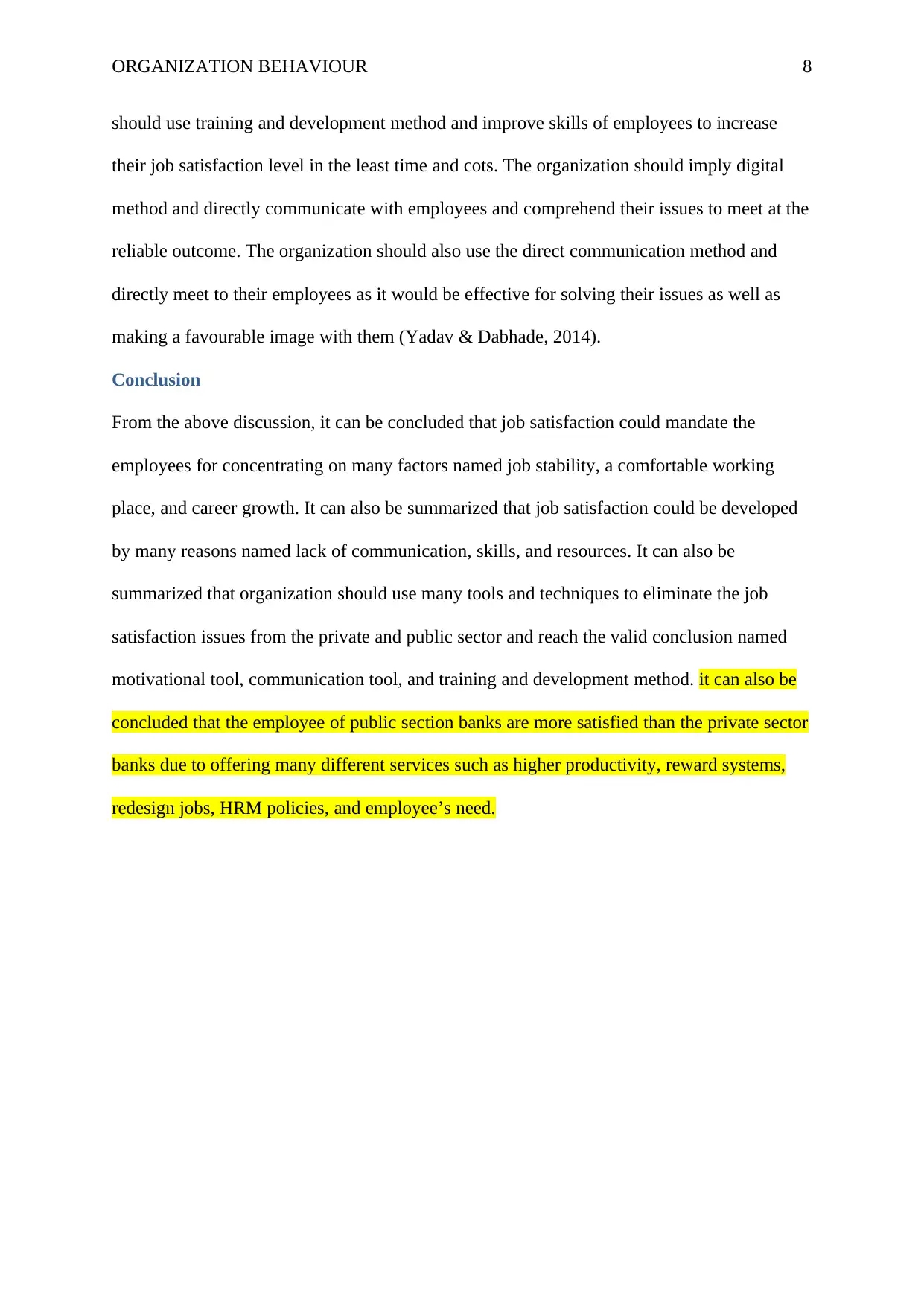
ORGANIZATION BEHAVIOUR 8
should use training and development method and improve skills of employees to increase
their job satisfaction level in the least time and cots. The organization should imply digital
method and directly communicate with employees and comprehend their issues to meet at the
reliable outcome. The organization should also use the direct communication method and
directly meet to their employees as it would be effective for solving their issues as well as
making a favourable image with them (Yadav & Dabhade, 2014).
Conclusion
From the above discussion, it can be concluded that job satisfaction could mandate the
employees for concentrating on many factors named job stability, a comfortable working
place, and career growth. It can also be summarized that job satisfaction could be developed
by many reasons named lack of communication, skills, and resources. It can also be
summarized that organization should use many tools and techniques to eliminate the job
satisfaction issues from the private and public sector and reach the valid conclusion named
motivational tool, communication tool, and training and development method. it can also be
concluded that the employee of public section banks are more satisfied than the private sector
banks due to offering many different services such as higher productivity, reward systems,
redesign jobs, HRM policies, and employee’s need.
should use training and development method and improve skills of employees to increase
their job satisfaction level in the least time and cots. The organization should imply digital
method and directly communicate with employees and comprehend their issues to meet at the
reliable outcome. The organization should also use the direct communication method and
directly meet to their employees as it would be effective for solving their issues as well as
making a favourable image with them (Yadav & Dabhade, 2014).
Conclusion
From the above discussion, it can be concluded that job satisfaction could mandate the
employees for concentrating on many factors named job stability, a comfortable working
place, and career growth. It can also be summarized that job satisfaction could be developed
by many reasons named lack of communication, skills, and resources. It can also be
summarized that organization should use many tools and techniques to eliminate the job
satisfaction issues from the private and public sector and reach the valid conclusion named
motivational tool, communication tool, and training and development method. it can also be
concluded that the employee of public section banks are more satisfied than the private sector
banks due to offering many different services such as higher productivity, reward systems,
redesign jobs, HRM policies, and employee’s need.
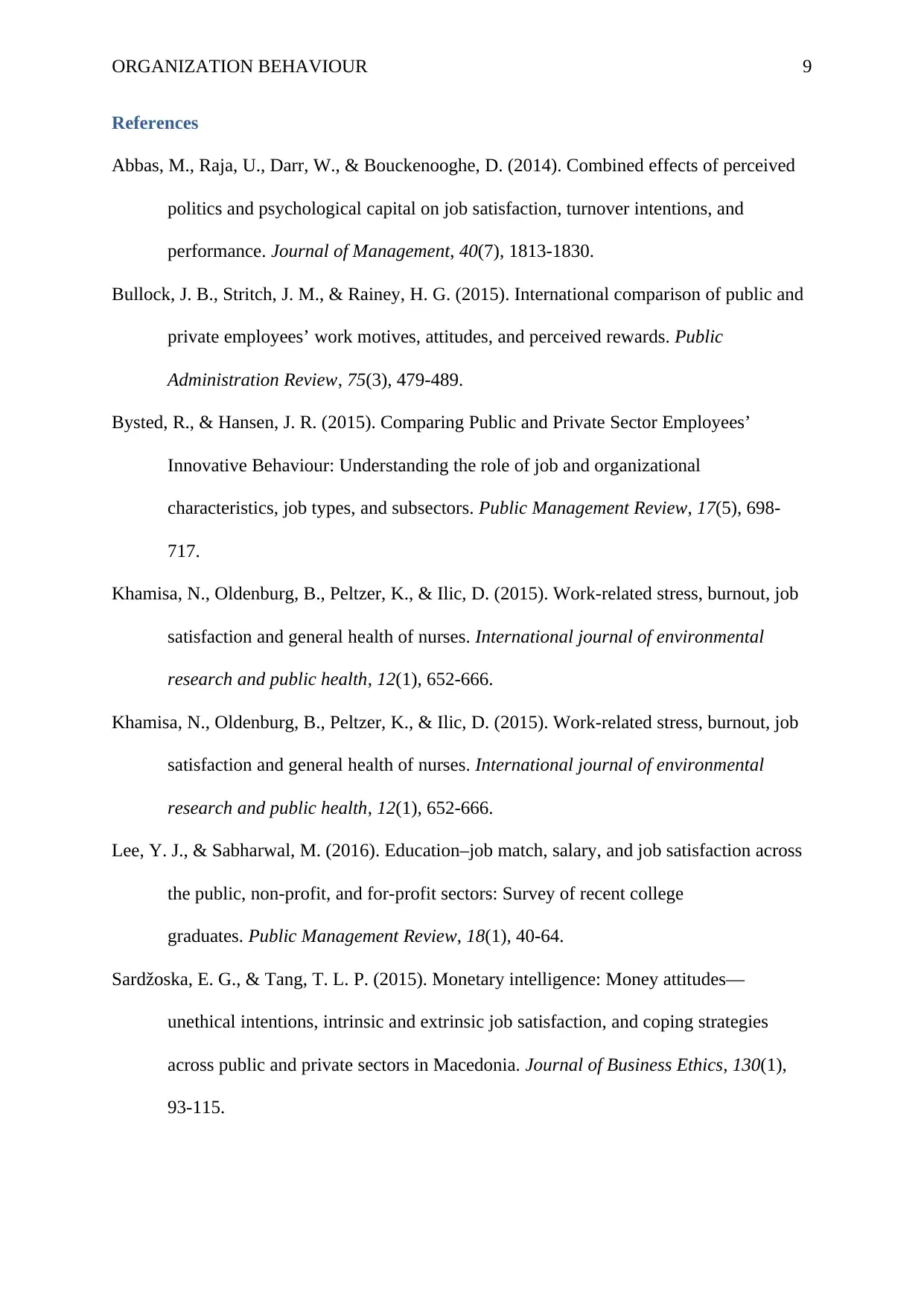
ORGANIZATION BEHAVIOUR 9
References
Abbas, M., Raja, U., Darr, W., & Bouckenooghe, D. (2014). Combined effects of perceived
politics and psychological capital on job satisfaction, turnover intentions, and
performance. Journal of Management, 40(7), 1813-1830.
Bullock, J. B., Stritch, J. M., & Rainey, H. G. (2015). International comparison of public and
private employees’ work motives, attitudes, and perceived rewards. Public
Administration Review, 75(3), 479-489.
Bysted, R., & Hansen, J. R. (2015). Comparing Public and Private Sector Employees’
Innovative Behaviour: Understanding the role of job and organizational
characteristics, job types, and subsectors. Public Management Review, 17(5), 698-
717.
Khamisa, N., Oldenburg, B., Peltzer, K., & Ilic, D. (2015). Work-related stress, burnout, job
satisfaction and general health of nurses. International journal of environmental
research and public health, 12(1), 652-666.
Khamisa, N., Oldenburg, B., Peltzer, K., & Ilic, D. (2015). Work-related stress, burnout, job
satisfaction and general health of nurses. International journal of environmental
research and public health, 12(1), 652-666.
Lee, Y. J., & Sabharwal, M. (2016). Education–job match, salary, and job satisfaction across
the public, non-profit, and for-profit sectors: Survey of recent college
graduates. Public Management Review, 18(1), 40-64.
Sardžoska, E. G., & Tang, T. L. P. (2015). Monetary intelligence: Money attitudes—
unethical intentions, intrinsic and extrinsic job satisfaction, and coping strategies
across public and private sectors in Macedonia. Journal of Business Ethics, 130(1),
93-115.
References
Abbas, M., Raja, U., Darr, W., & Bouckenooghe, D. (2014). Combined effects of perceived
politics and psychological capital on job satisfaction, turnover intentions, and
performance. Journal of Management, 40(7), 1813-1830.
Bullock, J. B., Stritch, J. M., & Rainey, H. G. (2015). International comparison of public and
private employees’ work motives, attitudes, and perceived rewards. Public
Administration Review, 75(3), 479-489.
Bysted, R., & Hansen, J. R. (2015). Comparing Public and Private Sector Employees’
Innovative Behaviour: Understanding the role of job and organizational
characteristics, job types, and subsectors. Public Management Review, 17(5), 698-
717.
Khamisa, N., Oldenburg, B., Peltzer, K., & Ilic, D. (2015). Work-related stress, burnout, job
satisfaction and general health of nurses. International journal of environmental
research and public health, 12(1), 652-666.
Khamisa, N., Oldenburg, B., Peltzer, K., & Ilic, D. (2015). Work-related stress, burnout, job
satisfaction and general health of nurses. International journal of environmental
research and public health, 12(1), 652-666.
Lee, Y. J., & Sabharwal, M. (2016). Education–job match, salary, and job satisfaction across
the public, non-profit, and for-profit sectors: Survey of recent college
graduates. Public Management Review, 18(1), 40-64.
Sardžoska, E. G., & Tang, T. L. P. (2015). Monetary intelligence: Money attitudes—
unethical intentions, intrinsic and extrinsic job satisfaction, and coping strategies
across public and private sectors in Macedonia. Journal of Business Ethics, 130(1),
93-115.
⊘ This is a preview!⊘
Do you want full access?
Subscribe today to unlock all pages.

Trusted by 1+ million students worldwide
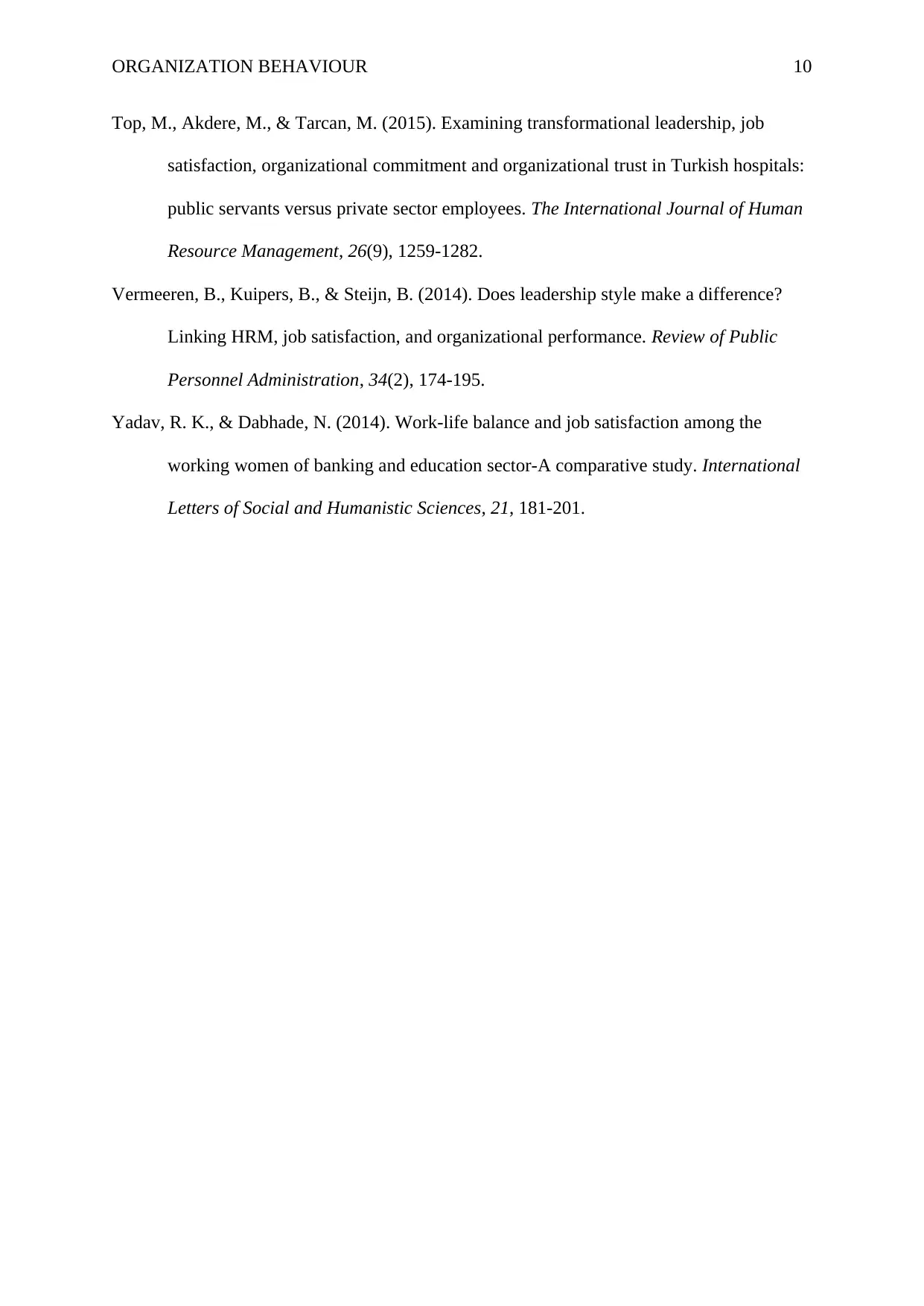
ORGANIZATION BEHAVIOUR 10
Top, M., Akdere, M., & Tarcan, M. (2015). Examining transformational leadership, job
satisfaction, organizational commitment and organizational trust in Turkish hospitals:
public servants versus private sector employees. The International Journal of Human
Resource Management, 26(9), 1259-1282.
Vermeeren, B., Kuipers, B., & Steijn, B. (2014). Does leadership style make a difference?
Linking HRM, job satisfaction, and organizational performance. Review of Public
Personnel Administration, 34(2), 174-195.
Yadav, R. K., & Dabhade, N. (2014). Work-life balance and job satisfaction among the
working women of banking and education sector-A comparative study. International
Letters of Social and Humanistic Sciences, 21, 181-201.
Top, M., Akdere, M., & Tarcan, M. (2015). Examining transformational leadership, job
satisfaction, organizational commitment and organizational trust in Turkish hospitals:
public servants versus private sector employees. The International Journal of Human
Resource Management, 26(9), 1259-1282.
Vermeeren, B., Kuipers, B., & Steijn, B. (2014). Does leadership style make a difference?
Linking HRM, job satisfaction, and organizational performance. Review of Public
Personnel Administration, 34(2), 174-195.
Yadav, R. K., & Dabhade, N. (2014). Work-life balance and job satisfaction among the
working women of banking and education sector-A comparative study. International
Letters of Social and Humanistic Sciences, 21, 181-201.
1 out of 10
Related Documents
Your All-in-One AI-Powered Toolkit for Academic Success.
+13062052269
info@desklib.com
Available 24*7 on WhatsApp / Email
![[object Object]](/_next/static/media/star-bottom.7253800d.svg)
Unlock your academic potential
Copyright © 2020–2025 A2Z Services. All Rights Reserved. Developed and managed by ZUCOL.





